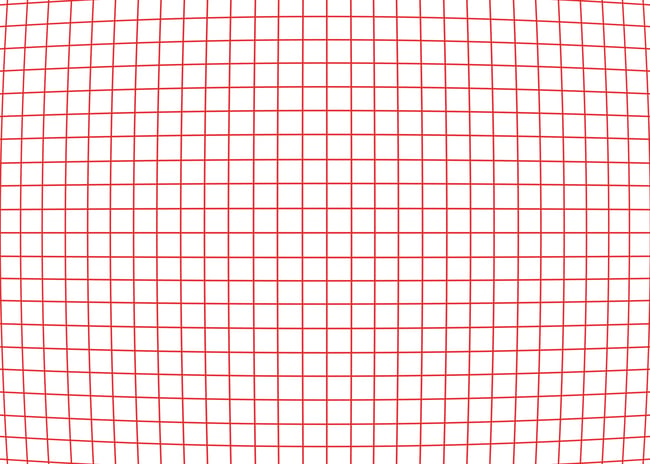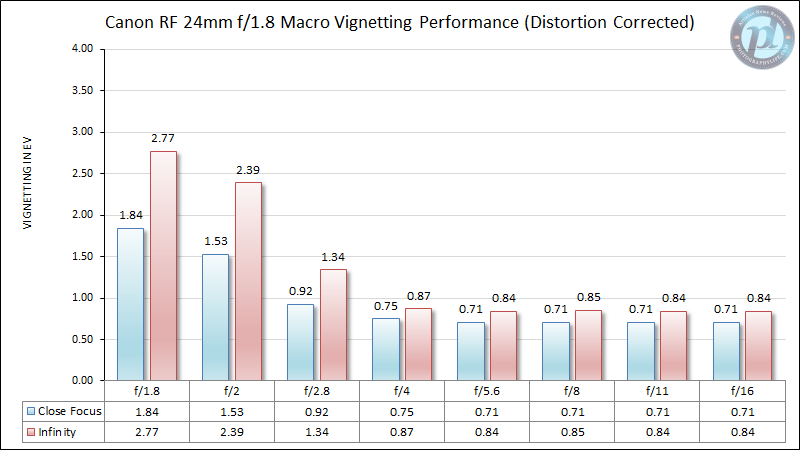Focus Speed and Performance
The Canon RF 24mm f/1.8 Macro focuses accurately and consistently, even in stringent lab conditions. In my experience, it also didn’t experience the focus hunting issue that I found with its sibling, the RF 35mm f/1.8 Macro. That said, I continue to think that a focus limiter switch would have been a very useful addition to this lens and could have sped up focusing even further.
Perhaps thanks to the external focusing design, the Canon RF 24mm f/1.8 Macro focuses a little more loudly than most modern lenses. This can be a problem for videography if you’re working with an on-camera mic, which is a shame, because it’s otherwise a good lens for quick video work.

Lastly, the close-focusing capabilities are – as expected from the lens’s name – excellent. It’s worth noting that the RF 24mm f/1.8 Macro is not a true macro lens that can reach life-size magnification (AKA 1:1 or 1x magnification). Instead, the lens can focus to half life-size, or 1:2 magnification (2x), which is still excellent for a 24mm prime.
Keep in mind that 24mm is a wide angle, so you’ll need to get very close to your subject if you want to do any near-macro photography. Since the lens barrel extends at close focus, you’ll almost be touching your subject at the point of closest focus. (The distance from the front of the lens to the subject is approximately 4 cm / 1.6 inches at closest focus.)
This can potentially scare away any skittish creatures that you’re photographing, and the shadow of the lens barrel can appear in some of your photos with this lens. Keep all that in mind before you start to think of it as a substitute for a longer macro lens.

Distortion
The Canon RF 24mm f/1.8 Macro has extremely high levels of distortion. In uncorrected images, it measures at -7.47% barrel distortion.
This continues the trend of some mirrorless lenses relying on extreme distortion correction in post-processing rather than fixing it in the lens design itself. Distortion can be corrected easily in post-processing, and this allows for lenses that are smaller and lighter. However, it’s not without tradeoffs. When correcting distortion to such an extreme extent as this, the corners of the photos need to stretch back into place, making them less sharp at a pixel level.
Here’s a simulation of -7.47% barrel distortion. It’s not quite fisheye territory (or Canon RF 16mm f/2.8 territory), but it’s a lot higher than I’d like. Distortion corrections are all but mandatory with this lens:

Vignetting
The Canon RF 24mm f/1.8 Macro has rather high vignetting wide open, especially when focusing at infinity. It improves significantly when you stop down.
I should note something important here. Vignetting is usually not tied very strongly to a lens’s level of distortion. However, when a lens’s distortion is as extreme as -7.47%, that means there is a big difference between how dark the corners look pre- and post-distortion correction.
As you can see in the following images, the Canon RF 24mm f/1.8 Macro’s corners are almost pitch-black until distortion correction has been employed, cropping those extreme tips out of the image:

Here’s our chart of vignetting performance after distortion has been corrected. Normally, our vignetting charts test a lens prior to correcting distortion, but when the lens has -7.47% barrel distortion, it just doesn’t make sense to shoot it uncorrected.

This is a pretty terrible result wide open and at infinity focus. It’s not the worst we’ve ever measured in the lab, but it’s higher than I’ve seen on any other 24mm f/1.8 prime. (For context, Nikon’s Z 24mm f/1.8 S maxes out at 1.94 stops. Sony’s 24mm f/1.4 GM reaches 2.07 stops despite being an f/1.4 lens. Even Viltrox’s 24mm f/1.8 AF performs a bit better at 2.45 stops.)
At least things improve substantially as you stop down – in fact, by f/2.8 and especially f/4, vignetting no longer bothers me at all on the Canon RF 24mm f/1.8 Macro. But that doesn’t make up for the f/1.8 performance.
Lateral Chromatic Aberration
The Canon RF 24mm f/1.8 Macro has a fairly low amount of chromatic aberration. Here’s the chart:

This is a good result. In our tests, anything under about one pixel is almost impossible to notice in real-world images, even with chromatic aberration corrections turned off. While the Canon RF 24mm f/1.8 Macro isn’t quite at that level, it’s very close. You’ll rarely see lateral CA on this lens, and if you do, correcting it in post-processing will be easy.
Sharpness
The Canon RF 24mm f/1.8 Macro has an interesting sharpness pattern. Its corners are very weak wide open, but central sharpness is already strong at f/1.8. It has very high central sharpness as you stop down – some of the best we’ve seen – and the corners pick up suddenly at f/4. See for yourself:

Because of this somewhat unusual sharpness pattern, I was curious if my sample of the lens was slightly decentered, which could explain the weak corners at f/1.8. I requested a second copy of the lens for testing and found that it performed almost exactly the same – if anything, a hair worse (not to the level that you’d see it outside of a lab context, though.)

This solidifies my impression of the Canon RF 24mm f/1.8 as a lens with very weak corners wide open, but a great center throughout the aperture range, and sharp through the corners starting at f/4.
I actually have no issue with this sort of sharpness performance. It’s rare that wide-open corner sharpness matters on a lens like this anyway, outside of some niche applications like Milky Way photography (where this wouldn’t be my first choice anyway, since I prefer sub-20mm lenses for photographing the Milky Way). Good central sharpness wide open, and good corner-to-corner performance at landscape apertures, is all I need to be satisfied. This lens accomplishes that.
Note that part of the corner weakness shown above can be explained by field curvature, which is relatively high on the RF 24mm f/1.8 Macro. Field curvature robs corner sharpness because the corners are actually out of focus. It’s most noticeable on a two-dimensional subject, such as a test chart or an overlook where everything is at infinity focus.
Finally, I did not experience any significant focus shift with the Canon RF 24mm f/1.8 Macro.
Early Access:
See all of our sharpness tests several weeks or months before we publish the full review. Support Photography Life today to get this benefit and much more! We are an ad-free website thanks to supporters like you.
Coma
Related to sharpness is coma, a lens aberration that can make dots of light in the corner of a photo look like smears. Coma isn’t usually visible in everyday photography, but for something like Milky Way photography, it can be a factor. Although I just said that I prefer wider lenses for Milky Way photography, let’s take a look at the 24mm f/1.8 Macro’s coma performance anyway.
The crops shown after the image below are extreme crops from the top-right corner of the Canon EOS R5 with the 24mm f/1.8 Macro. I cropped the R5’s 45-megapixel sensor down to 1500 × 1000 pixels and didn’t do any resizing – these are direct excerpts from the image with Lightroom’s default sharpening and noise reduction applied:



As you can see, the level of coma at f/1.8 is strikingly high, and the stars are soft overall. The image at f/2.8, however, is free from any major coma and actually looks pretty good (still a bit soft in the far corner, but hardly bad). This tracks with the sharpness results we measured in the lab: very weak corners at f/1.8 that improve substantially as you stop down.
Bokeh
Bokeh is another word for the qualities of the background blur in a photo. “Good” bokeh is completely subjective, since different photographers have their own preferences for how the background blur looks. That said, photographers commonly want their background blur to be soft, not distracting. Out-of-focus highlights that are round, uniform, and soft-edged are usually considered favorable.
Although a 24mm lens would not normally be a good choice for blurry backgrounds, the close focus capabilities of the Canon RF 24mm f/1.8 Macro tell a different story. At close-up distances, it’s very easy to get out-of-focus backgrounds with this lens.
Here’s how the bokeh appears in some sample photos, plus crops:






To me, this is really pleasant bokeh that you would never know came from a 24mm lens. Soft, creamy, and free from textures – it’s pretty close to ideal, at least to my eye.
Sunstars and Flare
The Canon RF 24mm f/1.8 has moderate flare, the shape of which changes slightly at different aperture settings. Below are some examples at f/1.8, f/8, and f/16:



As for sunstars, as you can see in the images above, you get pretty nice 18-point stars with the RF 24mm f/1.8 Macro so long as you’re at a narrow aperture around f/16 or f/22.

The next page of this review sums up everything and explains the pros and cons of the Canon RF 24mm f/1.8 Macro. So, click the menu below to go to “Verdict”:
Table of Contents